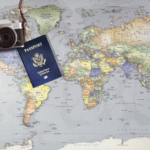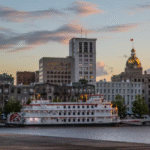The United States is a large country, home to a number of the world’s most iconic travel locations, each offering its very own charm depending on the season. From sun-soaked beaches and vibrant autumn foliage to snow-capped mountains and blooming spring gardens, the best time to visit each place hinges on what you want to experience. Understanding seasonal weather, crowd levels, and special events can dramatically shape your travel experience. Whether you’re planning a city escape, a nature retreat, or a coast-to-coast road trip, timing your visit to top US destinations can turn a good vacation into an unforgettable one.
Seasonal Strategies for Iconic Cities
Some of the most popular cities in the USA are best enjoyed when the weather is mild and the crowds are manageable. Take New York City, for instance. Spring (April to June) and fall (September to November) are the golden periods for visiting the Big Apple. Central Park bursts into color during these seasons—either with spring blooms or fiery autumn foliage—while the temperatures remain pleasant for walking and sightseeing. The summer months bring intense heat and overwhelming tourist crowds, while winter can be bitterly cold, although December has its magical holiday appeal.
In comparison, San Francisco enjoys a Mediterranean-style climate, but it’s most agreeable from September to November. During this time, the fog often clears, the air is crisp, and hotel rates tend to be lower than during the summer rush. Chicago, known for its icy winters, shines best from late May through October. Lakefront festivals, architectural river tours, and open-air events make the Windy City vibrant and alive. For Las Vegas, spring and fall offer more comfortable temperatures compared to the searing desert heat of summer. Although summer draws party-goers and pool enthusiasts, outdoor activities are limited due to the sweltering sun.
Washington, D.C., is also worth noting. Cherry blossom season, usually late March to early April, transforms the capital into a pastel wonderland. The National Cherry Blossom Festival draws thousands of visitors, so early bookings are crucial. Meanwhile, fall offers cool temperatures and fewer tourists, perfect for exploring monuments and museums at your own pace.
Nature at Its Peak: National Parks and Scenic Landscapes
The US is home to over 400 national park sites, but only a few receive the bulk of tourism. Places like Yellowstone, Yosemite, and the Grand Canyon are breathtaking, but when you visit makes all the difference. Yellowstone National Park is best visited from May to June and September to early October. These shoulder seasons offer great weather, reduced crowd sizes, and active wildlife. July and August bring the heaviest foot traffic, which can mean long lines at park entrances and crowded trails.
Yosemite National Park follows a similar pattern. Late spring sees the waterfalls in full force as snow melts from the Sierra Nevada mountains, while autumn brings crisp air and quieter trails. Winter has its charm too, especially for those interested in snowshoeing or cross-country skiing, though access may be restricted.
The Grand Canyon is most enjoyable from March to May and September to November. Temperatures are cooler, especially along the South Rim, and the trails are less congested. Summer, although popular, can be dangerously hot, particularly for hiking in the canyon itself. In contrast, Acadia National Park in Maine showcases its best colors in the fall, typically from late September to mid-October. This is when the foliage is most vibrant and the park takes on a postcard-like appearance.
The Smoky Mountains are another crowd favorite, particularly in October when the leaves transform into a stunning display of reds, oranges, and yellows. Springtime is also beautiful here, with blooming wildflowers and bear sightings becoming more frequent. Zion National Park and Bryce Canyon in Utah are best in spring and fall as well, offering comfortable temperatures for exploring their surreal desert landscapes.
Coastal Escapes and Beach Bliss
For travelers attracted to the coastlines, both East and West offer varied experiences throughout the year. In California, coastal towns like Los Angeles and San Diego are blessed with year-round mild weather. However, late spring and early fall are especially appealing due to thinner crowds and perfect beach conditions. You’ll also avoid the June Gloom—coastal cloud cover that can persist into early summer. These off-peak months offer warm sand, cool breezes, and more affordable lodging.
Florida, home to some of the best beaches in the country, is most enjoyable from November through April. The weather is sunny, warm, and low in humidity—perfect for beach lounging and water sports. Summer in Florida can be hot and stormy, often interrupted by afternoon thunderstorms or the occasional hurricane warning. Miami, Key West, and Clearwater all experience bustling energy during the dry season, with plenty of outdoor festivals, concerts, and art shows to keep you entertained.
The Northeast coastal regions, like Cape Cod and the Hamptons, are summer hotspots, attracting beachgoers between June and August. But those in the know often prefer early September, when the water is still warm but the crowds have thinned. On the opposite side of the country, the Pacific Northwest’s coastal areas like Cannon Beach in Oregon or Olympic National Park in Washington are best seen during the summer, when rainfall is at its lowest and the rugged coastline comes alive with outdoor activity.
Hawaii, often seen as the ultimate island escape, can be visited year-round, but the best times are typically from April to June and September to mid-December. These months offer fewer crowds, lower costs, and fantastic weather. Whale watching is best between January and March, while surfing conditions peak in winter. However, summer brings calmer ocean waters, perfect for snorkeling and swimming.
Festivals, Local Events, and Avoiding the Rush
Beyond weather and scenery, the cultural rhythm of a destination also defines the best time to visit. Some cities and regions come alive during major events, offering visitors a deeper connection to the local culture. New Orleans, for example, is best known for Mardi Gras in late February or early March. Although this is peak tourist season, the electric atmosphere and colorful parades make it worth the crowds. Alternatively, visiting in early fall offers warm weather and lively music festivals without the chaos of Carnival.
Austin, Texas, becomes a cultural hotspot during March when SXSW (South by Southwest) takes over the city with music, film, and tech showcases. Fall is also a great time to visit, thanks to pleasant temperatures and a packed calendar of food and music events. Similarly, Nashville and Memphis hum with energy during the spring and early summer, when outdoor concerts and festivals are in full swing.
In the Midwest, the Minnesota State Fair in late August draws huge crowds and provides a quintessential slice of Americana. Chicago’s Taste of Chicago food festival in July and Lollapalooza music festival are equally iconic. If your interests lie in historical events and reenactments, Colonial Williamsburg in Virginia or Gettysburg in Pennsylvania often host living history events, especially during the spring and fall seasons.
One way to avoid peak-season pricing and tourist congestion is to travel during the “shoulder season”—typically the few weeks before or after a destination’s high season. Not only will you enjoy fewer crowds, but hotels and flights are often more affordable. For example, visiting Orlando’s theme parks in early May or mid-September allows you to experience shorter lines and lower hotel rates, all while avoiding the oppressive summer heat.
Final Thoughts
The best time to visit popular US destinations varies widely depending on location, weather, activities, and your personal travel goals. While summer is traditionally the peak travel season, it isn’t always the ideal time, especially when considering extreme temperatures and large crowds. Instead, spring and fall often provide the perfect balance of pleasant weather, vibrant scenery, and manageable tourism. Whether you’re exploring natural wonders, relaxing on sandy beaches, or diving into the energy of a major city event, planning your trip with the right seasonal insight can make all the difference. By aligning your travel dates with the rhythms of each destination, you can enjoy a more immersive, enjoyable, and stress-free journey across the US.






